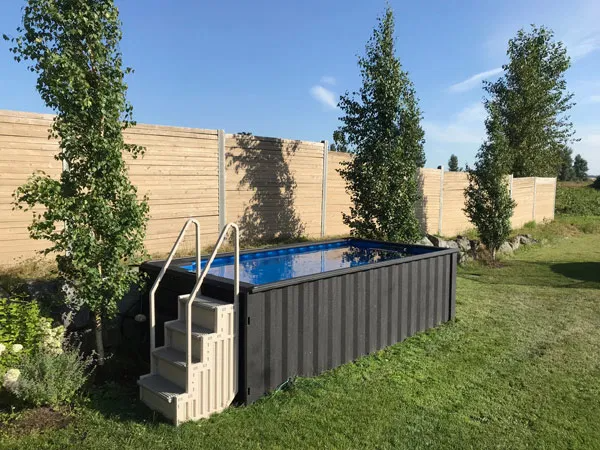Are Shipping Container Pools Worth It? Shipping Container Pools vs Traditional Pools vs Plunge Pools
With changing lifestyles and a focus on innovative design, there is an increasing interest in alternate methods to traditional pool installation. One such innovation is the Shipping Container Pool.
Shipping Container Pools
Shipping container pools are modified shipping containers with necessary pool components like waterproof lining, filtration systems, etc. The primary appeal lies in their novelty, flexibility, and potential affordability. Luxury options include built-in heating systems, glass side windows, LED lighting, and more.
Traditional Pools
Traditional pools are often in-ground and made of concrete, fiberglass, or vinyl. The process requires extensive construction work, such as excavation, setting up the pool structure, and implementing plumbing systems.
Plunge Pools
A plunge pool is a small, shallow pool built for the purpose of lounging, wading, and cooling off instead of for swimming and exercising. The size and design of plunge pools can vary greatly, but they are typically smaller than conventional swimming pools, which makes them an attractive option for homeowners with limited outdoor space.
How Much Does It Cost To Convert A Shipping Container Into A Pool?
The affordability of shipping container pools depends on multiple factors:
Initial Costs
The basic price of a standard-sized shipping container can range from $2,000 to $3,000. However, the conversion process, including installing the waterproof lining, plumbing, and filtration systems, adds to the initial cost.
Full Conversion Costs
Manufacturers offer fully converted shipping containers ready for use as pools. The prices can vary from $20,000 to $90,000, depending on the size, depth, and additional features.
Transport and Installation Costs
Transporting and installing the pool could add to the overall cost. However, the advantage of a shipping container pool is its portability. They can be placed anywhere on the property and even relocated if necessary.
The Costs of Traditional Pools
Traditional pools involve different kinds of costs:
Construction Costs
The bulk of the cost for traditional pools comes from the construction process. The extensive work of excavating the ground, laying the plumbing, and constructing the pool can significantly add to the total cost.
Installation Costs
Depending on the material, size, and design, traditional in-ground pools can range between $28,000 and $55,000 just for the installation of the pool itself. Additional costs include the installation of filtration and heating systems, as well as landscaping around the pool.
Cost Comparisons and Considerations
When comparing the costs of the two, both initial and long-term costs should be considered.
Initial Costs
Shipping container pools might appear to be the cheaper option initially, especially compared to higher-end traditional pools. However, potential repair and maintenance costs over time could add up.
Long-term Value
Traditional pools often provide better long-term value. They are usually more durable and can add more value to a property.
Portability and Flexibility
Shipping container pools offer greater flexibility and portability, allowing easy relocation, a crucial deciding factor for those not planning a long-term stay at their current residence.
Environmental Impact
Shipping container pools can be considered more environmentally friendly as they repurpose used containers. However, potential homeowners need to ensure the container they choose is in good condition and free of harmful substances.
Conclusion and Future Trends
In conclusion, the affordability of shipping container pools vs traditional pools depends heavily on individual circumstances and preferences. Factors like desired pool size, additional features, location, and long-term plans can tip the scales.
Shipping container pools are gaining popularity due to their lower initial cost and flexibility. They also align with the increasing focus on sustainable living. Meanwhile, traditional pools remain a timeless addition to homes, offering a sense of permanence and aesthetic appeal.
In the future, we may see a blend of these two pool types, combining the affordability and flexibility of shipping container pools with the durability and visual appeal of traditional pools. As innovation in design and technology continues to evolve, the future of the swimming pool industry looks promising.
Whether you're considering a shipping container pool or a traditional one, remember to check local regulations and permits required for installing pools. Also, consider the long-term maintenance costs and the potential increase in property value.
Both types of pools serve their primary purpose - to offer a space for recreation, relaxation, and fun. The decision should be based on a combination of personal preference, budget, and long-term value. You can find a wide range of pool features at Backyard Escapism like scuppers, and fire and water bowls which can enhance the aesthetics and functionality of your pool. Regardless of the type you choose, the joy of owning a pool is an unparalleled experience.

